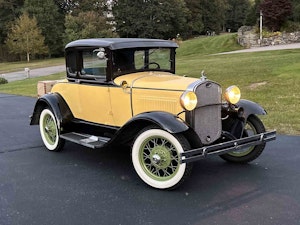Media | Articles
Underappreciated 1970–73 Chevy Camaro Z/28s are a decent value
It’s easy to forget about the second-generation Camaro Z/28, or at least overlook it. Most people picture the fatter, slower, decal-laden Camaros of the late 1970s when talking about that era of Z/28s, and the serious money typically goes after the initial and more hardcore 1967–69 cars. For a few short years in the beginning of the ’70s, however, Z/28s still offered serious high performance and wrapped it up in an attractive European-inspired package with chrome bumpers, smooth coupe bodywork, and an enormous square grille.
And these days, 1970–73 Z/28s offer a pretty solid value in terms of performance, appearance, and rarity—and prices have really gone anywhere lately, either.
While the Z/28 was conceived as a Trans Am racer for the road, with a high-revving 302 and a close-ratio four-speed only, the new 1970 version was a slightly more civilized model with an available automatic. That said, it was no pretender. The Z/28 package still came with heavy duty suspension and Positraction axle, and under the hood was a 360-horse version of the fantastic solid lifter, high-compression LT1 engine out of the Corvette. Air conditioning wasn’t even available in the Z/28 until 1973.
20181010203404)
20181010203422)
Marketplace
Buy and sell classics with confidence
20181010203338)
Of the 1970–73 Camaro Z/28s, the ’70 is naturally the most desirable because with each subsequent year, a little more performance got choked out of the Camaro as muscle cars fizzled out through the end of the decade. By 1971, the LT1 engine was down to a still-respectable 330 hp, but by 1972 the figure (now measured in net rather than gross) was down to 255 hp, and 1973 lost another 10 horses.
Aside from badges, seats and grille, however, 1970–73 Z/28s look mostly the same. As for rarity, there were less than half as many Z/28s built in 1970 as there were in ’69—fewer than 9000, compared to more than 20K the year before. Even rarer are models from 1971 (fewer than 5000) and ’72 (just over 2500). In 1973, Z/28 sales rose to more than 11,500, before the Camaro was significantly restyled for 1974.
As for desirable options, expect to pay more for a four-speed. And the Rally Sport (RS) package, which features bumperettes on either side of the grille instead of a full-length bumper, is particularly valuable. Expect to pay as much as a 20-percent premium for a split-bumper RS/Z28 over a normal Z.
20181010203254)
As for values, these cars didn’t take as much of a dive as a lot of American muscle cars did in 2008, but they’ve also been relatively flat compared to similar cars and aren’t showing signs of picking up again any time soon. Average values for 1970–73 Z/28 models are up 15 percent in the last 10 years and 12 percent in the last five years, but only 4 percent in the last 12 months—mostly due to some upward movement specific to 1971 models. Otherwise, things have looked mostly the same, price-wise, for the last year and a half.
There have been a few huge standout sales, including an all-original 1970 model for $110,000 at Mecum Indy last year and $88,000 for an RS/Z28 at Barrett-Jackson Palm Beach this year, but these haven’t proven to be curve-setting results. Average value of a condition #2 (Excellent) 1970 car currently sits at $53,700, and prices fall year by year until the 1973 model, which currently sits at $34,900 for a #2 car.
Buyer interest for these cars, as measured by insurance quote activity, has been essentially flat over the past three years. Gen X and Millenial enthusiasts account for 55 percent of the quotes, which means that interested buyers are younger than average (but only by 3 percent).
20181010203503)
20181010203524)
The Z/28 badge is almost as famous as the Camaro, but Z/28s have also had a pretty mixed history. In between the rev-happy Trans Am racers of the ’60s and the softer cars of the late ’70s and ’80s, there was a spot in the middle when the Z/28 still packed a serious punch—even without the iconic styling or the motorsport connection of the first-generation cars.
These cars live in the shadow of the earlier ones while still offering quite a bit of Camaro goodness, all things considered, but at current prices the 1970–73 Z/28 is past entry-level territory and prices out a sizable chunk of buyers. Looking at recent trends, they also seem fully priced and aren’t likely to make any big movement any time soon, so there probably isn’t any reason to rush things, whether you’re buying or selling one.
20181010203307)








20181010203435)
20181010203446)
20181010203514)

